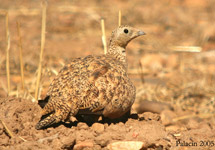HNV Farming & Biodiversity
Cereal steppes of Rio Jarama & Henares (Spain)

Natura site name: SPA Cereal steppes of Rio Jarama and Henares (Madrid)
Natura Code: ES 3110001
This landscape is typical of large areas of the Spanish interior that are dominated by extensive cereal cropping favouring the maintenance of a highly diverse steppeland bird community, including many species of conservation concern. The characteristics that make this an HNV farming landscape include the mosaic of low-intensity cropping with a large proportion of fallow land, interspersed with semi-natural vegetation.
The SPA was declared in 1992, and was later incorporated into the SAC Cuencas de los ríos Jarama y Henares (Natura 2000 fiche). The SAC covers 36,088 hectares and is dominated by extensive cereal cultivation (75% of the area).








